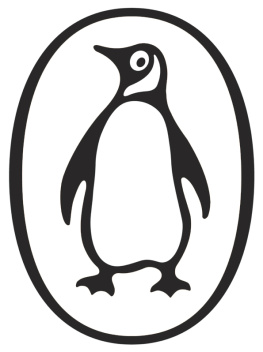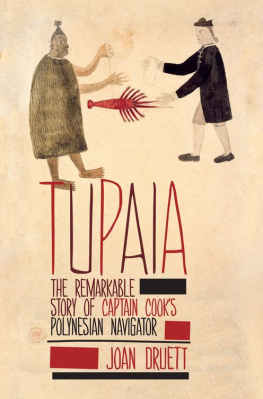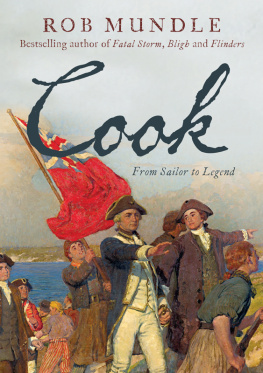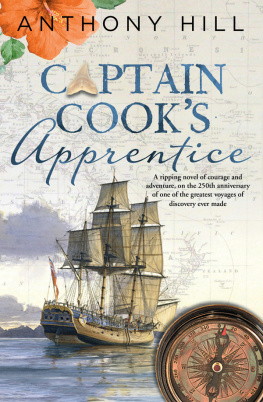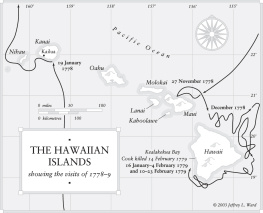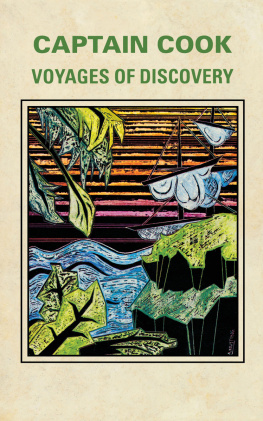
THE JOURNALS
JAMES COOK was born in Marton, Yorkshire, in 1728, the son of an agricultural labourer. Apprenticed to a Whitby shipowner, he joined the Navy in 1755, becoming Master in 1757. Cook led three expeditions to the Pacific Ocean. The first, from 1768 to 1771, as Lieutenant in the Endeavour; the second, from 1772 to 1775, as Commander in the Resolution, accompanied by the Adventure; and the last, from 1776 until his death in 1779, as Captain in the Resolution, accompanied by the Discovery. Cook did more than any other navigator to add to our knowledge of the Pacific and Southern oceans, circumnavigating and charting New Zealand, surveying and claiming the east coast of Australia, exploring the extent of Antarctica, visiting Tahiti and discovering island groups like New Caledonia and Hawaii. He died on 14 February 1779, in Hawaii, after being forced to turn back during his attempt to find a passage around the north coast of America from the Pacific. The inhabitants of the island, while friendly to begin with, killed Cook when he landed to recover a stolen boat.
Cook wrote in great detail about his voyages, to begin with for the eyes of the Admiralty, but then, having been upset by the authorized account published by Dr John Hawkesworth, with a view to his work being read by the public. His first, and only, publication, was A Voyage Towards the South Pole and Round the World (1777).
PHILIP EDWARDS has been a professor of English Literature at Trinity College Dublin, Essex University and Liverpool University, and has held visiting posts in the United States, Canada, New Zealand and Japan. He is now in retirement, Emeritus Professor of English at Liverpool University. He is a Fellow of the British Academy. During the Second World War he served with the Royal Navy in both the Indian and Pacific oceans.
He is the author of numerous studies on the literature of voyages, including Last Voyages: Cavendish, Hudson, Ralegh (1988) and The Story of the Voyage: Sea Narratives in Eighteenth-Century England (1994). He has also written widely on Shakespeare and the literature of his time, including Shakespeare and the Confines of Art (1968), Threshold of a Nation (1979), Shakespeare: A Writer's Progress (1986) and Sea-Mark: The Metaphorical Voyage, Spenser to Milton (1997). He has edited Pericles and Hamlet, and Kyd's Spanish Tragedy, and co-edited the plays of Massinger.
JAMES COOK
The Journals
Prepared from the original manuscripts by
J. C. Beaglehole for the Hakluyt Society, 195567
Selected and edited by
PHILIP EDWARDS
PENGUIN BOOKS
PENGUIN BOOKS
Published by the Penguin Group
Penguin Books Ltd, 80 Strand, London WC2R 0RL , England
Penguin Putnam Inc., 375 Hudson Street, New York, New York 10014, USA
Penguin Books Australia Ltd, 250 Camberwell Road, Camberwell, Victoria 3124, Australia
Penguin Books Canada Ltd, 10 Alcorn Avenue, Toronto, Ontario, Canada M4V 3B2
Penguin Books India (P) Ltd, 11 Community Centre, Panchsheel Park, New Delhi 110 017, India
Penguin Books (NZ) Ltd, Cnr Rosedale and Airborne Roads, Albany, Auckland, New Zealand
Penguin Books (South Africa) (Pty) Ltd, 24 Sturdee Avenue, Rosebank 2196, South Africa
Penguin Books Ltd, Registered Offices: 80 Strand, London WC2R 0RL , England
www.penguin.com
First published by the Hakluyt Society 195567, in 4 volumes
Published in Penguin Classics as The Journals of Captain Cook 1999
Reprinted under the present title with new Further Reading 2003
This selection, introduction and editorial material copyright Philip Edwards, 1999, 2003
All rights reserved
The moral right of the editor has been asserted
Maps by Nigel Andrews
Except in the United States of America, this book is sold subject to the condition that it shall not, by way of trade or otherwise, be lent, re-sold, hired out, or otherwise circulated without the publisher's prior consent in any form of binding or cover other than that in which it is published and without a similar condition including this condition being imposed on the subsequent purchaser
ISBN: 9781101489567
CONTENTS
LIST OF MAPS
VOYAGE MAPS
1. The First Voyage, 17681771:
August 1768 October 1769
2. The First Voyage, 17681771:
October 1769 July 1771
3. The Second Voyage, 17721775:
July 1772 October 1773
4. The Second Voyage, 17721775:
October 1773 July 1775
5. The Third Voyage:
July 1776 February 1779 (the death of Cook)
LOCATION MAPS
GENERAL INTRODUCTION
James Cook led three famous expeditions to the Pacific Ocean: in the Endeavour (as lieutenant) from 1768 to 1771; in the Resolution (as commander), with the Adventure, from 1772 to 1775; and in the Resolution again (now captain), this time with the Discovery, from 1776 until his death in Hawaii in 1779. Accounts of these voyages, based on Cook's journals, were published at the time, soon after the completion of each voyage, but it was not until halfway through the twentieth century that the texts of Cook's own manuscripts were made available, in a monumental edition by John Cawte Beaglehole for the Hakluyt Society. great seaman's presence. It is my hope that this shortened version preserves the spirit and the rhythm of Cook's narrative, and, without doubt, compression of the full texts into manageable form has advantages of its own. All omissions are clearly indicated and I have provided short narratives to cover gaps of importance. There is a new introduction to each voyage, and a Postscript in which I give my understanding of events from the point at which Cook's journal breaks off until his death.
Cook gave an enormous amount of time and labour mostly at sea but also ashore to writing up the story of his voyages, constantly revising and rewriting, and it was no easy matter for Beaglehole to choose, for each of the voyages, the version of the journal which was best to print. Cook kept his own log of the ship's movements and daily events (separate from the official ship's log) and from this he wrote up what he called on the first voyage the remarkable occurrences meaning of course things worthy of note, not just out-of-the-way things. On this first voyage Cook was not expecting his account to be published, but he was certainly preparing it with an audience in mind the Admiralty, to whom he was required to report and he often rewrote what he had first set down. Even when he had given his clerk his own revised version to copy out fair for their Lordships, he might still continue to make alterations.
What the Admiralty did with their copy of Cook's journal for the first voyage was to hand it along with the journals of Byron, Wallis and Carteret from earlier expeditions to Dr John Hawkesworth to prepare an authorized history of recent voyages. Cook did not see Hawkesworth's three volumes, published in 1773, until he was at the Cape of Good Hope in 1775, near to the end of his second voyage. He was deeply upset by the freedom Hawkesworth had taken with his work, altering and omitting what he had written and supplying him with sentiments he had never expressed, and making a prodigious profit into the bargain. Even if the thought that he might be the author of his own story had crossed his mind before, it would seem that from then on he was quite determined that he should be in charge of the authorized account, and, to judge from the extant manuscripts, the amount of writing and rewriting now undertaken by this unlettered seaman to provide an account of his second voyage satisfying to him and suitable for the public was extraordinary. Cook won from the Admiralty the permission to publish, and took his manuscript to Canon John Douglas to be edited, being careful to explain in the preface that he had not had the advantage of much school education, having been mostly at sea since his youth.
Next page
